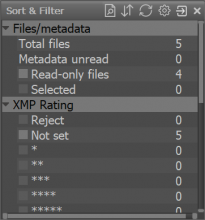Sorting and filtering files in a folder
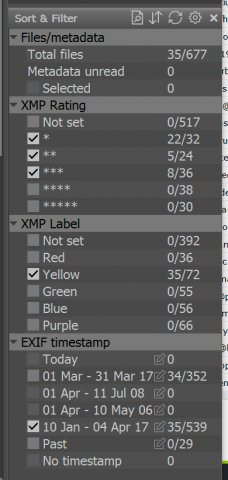 The sorting and filtering of files is controlled via the Sort & Filter panel, which, by default, is located in the right-hand column of panels.
The sorting and filtering of files is controlled via the Sort & Filter panel, which, by default, is located in the right-hand column of panels.
The following icons are placed at the title bar of this panel (left to right)
- Filter files by name/mask
- File Sorting
- Re-reading the current folder
- Panel Settings.
The panel displays filtration parameters, which extend the filtration over ratings/labels that we had in previous versions.
File Sorting
The sorting of files can be set in the menu that appears when pressing the sorting icon (second from the left in the panel header).
The following sorting methods are supported:
- By filename, natural (meaning that numeric components will be sorted by value).
- By filename, alphanumerically (meaning that 11 will precede 2)
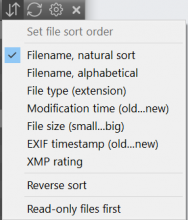
- By file type (extension)
- By file modification time
- By file size
- By shooting date (EXIF Timestamp)
- By XMP rating
- Reverse sorting order
- Read-only/Locked/Protected first – see the section Working with Read-Only/Locked Files below
In cases when two files have the same value for the category by which they are being sorted, the natural filename is used as an additional “sorting key” (when sorting by filename, the file extension is the second key).
To sort by metadata, which needs to be read from the file (EXIF, XMP), the sorting occurs dynamically and is animated, synchronously with the reading of the current folder.
File filtration
Filtration is controlled by the rest of the new Sort & Filter panel. The panel displays the types of parameters (XMP Rating, XMP Label, EXIF Timestamp) and value options. You can check the checkbox to the left of the sorting and filtering parameter, and only files that pass the filtering conditions will be displayed.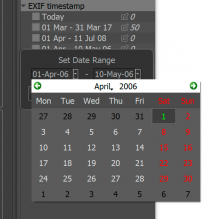
In the Exif Timestamp group, you can select the necessary ranges of dates. You can edit those ranges if necessary, changing the standard Today/Yesterday/This Week/… tailoring them to your current needs. The number of ranges is fixed. The first value for the range is always “from;” the second is always “to.”
Aside from setting 'fixed' date ranges, using calendar days, date ranges can also be set in the form "last NN days." In this case, the boundaries for the date range are calculated as “from NN days ago to today.” Last “1 days” is a synonym for “today.”
The boundaries of the range of dates for Last NN days is set:
- At the moment of pressing the “OK” button, when editing the range.
- At the moment of launching the program, when applying a date range that is already defined in the settings.
This way the “Last NN days” range will not change the actual range of absolute calendar dates even if during the course of work the current date has changed.
If there are any selected files in the folder (see the next section), you can check the checkbox to the left of the word Selected in the Files/Metadata group, and only the selected files will be displayed. In this case, if you unselect some file, it will be excluded from the display, which means that in order to have it displayed again, you need to uncheck Selected and select the file again, after which you can check Selected once more.
The filtration inside one group is of OR-type. The filtration among groups is AND-type. That is, if, for example, you select XMP Label Yellow and XMP Label Green, files that have either of those two labels will be displayed. If, however, you checked XMP Rating: 3, XMP Label: Green, and EXIF Timestamp: This week, only the files which conform to all three conditions simultaneously will be displayed.
The numbers in the respective lines indicate how many files there are with a given parameter value. If the numbers are in the form nn/mm, mm indicates how many files with the given parameter value are present, while nn indicates how many of those passed through the filters. If only one number is indicated, then all of the files passed through the filters. If the numbers are displayed in italics, the reading of the metadata is still in progress.
With standard settings, the metadata (EXIF, XMP) is read only when this data is needed – for Icon display, or when filtering is on. This accelerates the browsing. This can be changed in the preferences by switching off File Handling - Sorting and Filtering - Lazy metadata read
Filtration: saving, cancelling, and restoring
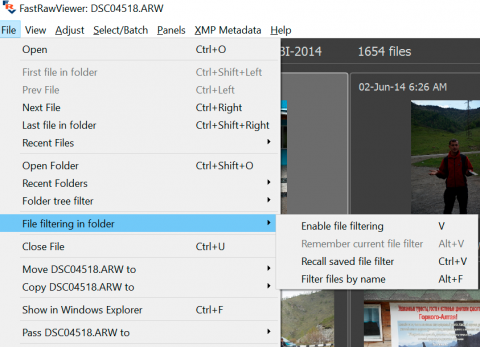 To save, cancel, and restore filters, use the new File - File filtering in folder submenu, or use the corresponding hotkeys.
To save, cancel, and restore filters, use the new File - File filtering in folder submenu, or use the corresponding hotkeys.
- Disable/Enable file filtering (assigned to V by default) flips the status of filtration. If it’s on, it’s switched off; the filtering conditions are temporarily stored so that when the filtering is re-enabled, the previous filtering conditions are automatically applied.
- Remember current file filter (assigned to Alt-V by default). This action stores the filtering conditions in a non-volatile fashion. This filtration is preserved and can be recalled through Recall saved filter even after program restart:
- Recall saved file filter (Ctrl-V) – restores the non-volatile saved filter settings.
- Filter files by name – turns on/off the filtration of files by filename (please see below)
If the setting File Handling - Reset filtering on folder change is on, Disable file filtering will be automatically triggered when the folder is changed while the filtration is on; the filter settings will be preserved and recallable through the V hotkey.
Filtering by filename
Filtering by filename is switched on and off through Menu - File - File filtering in folder - Filter files by name (Alt-F) or the “page with magnifying glass” button, located in the Sort & Filter panel’s title bar.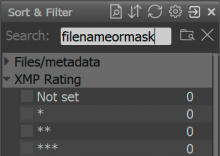
When this filtration is on, an edit line appears that allows one to enter:
- a substring of any symbols that are contained in the filenames of the images that you want to be displayed
- a mask for the filename (this condition is recognized by the presence of the * symbol in the edit)
- A regular expression in PCRE syntax; this is recognized by the / symbol in the first position of the edit line; this symbol will be ignored when evaluating a regular expression.
After pressing Enter (or the folder-with-magnifying-glass icon located to the right of the edit line), the files in the current folder will be filtered, i.e., only the names of the files that meet the condition in the edit line will be displayed. Any other present filtering conditions such as label/rating/date/etc., are also applied.
Name filtering precedes metadata filtering. This filter isn’t cancelled/restored/saved/recalled by the Disable/Enable/Remember/Recall actions (see above) and isn’t switched off when moving to a different folder.
Other parameters and properties of the Sort & Filter panel
 The Refresh button in the title bar opens a menu with two items:
The Refresh button in the title bar opens a menu with two items:
- Re-read current folder – the current folder will be re-read as if it has just been opened with Menu - File- Open Folder - Open folder (but the current file will still be displayed or highlighted).
- Forced full metadata read – the metadata of all files will be re-read (as if Lazy metadata read were turned off).
Panel settings (gear icon)
- Show Files/Metadata status – turns on the display of this group in the statistics/selection table

- Show Selected files – turns on the display of the Selected line in the current group.
- Show zero values for completely fetched data – if this setting is off, then the table display the lines that do not don’t correspond to any of the files in the current folder. Display is only turned off when the metadata for all of the files in the folder has been read.
- Hide groups with only one value – if the corresponding group (XMP Rating, Label, EXIF Timestamp) contains the same data; in other words, all of the files in the current folder fall into the same line in the group, the entire group will be hidden.
Additional sorting and filtering settings are described in the “Program Settings” section below.
Working with Read-Only/Locked Files
Most digital cameras allow one to set the Protected or Locked attribute for files picked by the photographer. When importing (copying) RAW files from a memory card, this is translated as:
- Windows: Read-Only attribute
- Mac OS X/macOS: uchg (UF_IMMUTABLE) flag, which is translated in the Finder as locked (padlock symbol).
These attributes are kept when copying/moving files using standard system methods.
FastRawViewer works with such files in the following way: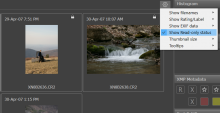
I. In Grid View mode, Locked files are displayed with a “padlock” symbol.
Displaying the “padlock” is turned on or off through the Show Read-only status (Locked/Read-only on Mac) in the Grid/Filmstrip settings, by default turned on for Grid, off for Filmstrip.
II. If there are one or more Read-only/locked file in the folder, then the line Read-only files (Locked/Read-only on Mac) appears in the Files/Metadata section of the file filtration panel. If it’s checked with a checkmark, then only Read-only/Locked files will be displayed.
III. In the sorting preferences (see above), one can set the Read-only files first (Locked/Read-only on Mac) setting, and then such files will be displayed at the beginning of the list in Filmstrip/Grid (the order within the RO/Locked group, and others, is set by the other sorting settings).
IV. When copying/moving files using FastRawViewer, the attributes are kept.
V. On Mac, with default settings, the moving of locked files is forbidden. The Copy/Move/Reject - Allow move/reject for locked files setting allows for the moving of such files and placing them in _Rejected.

